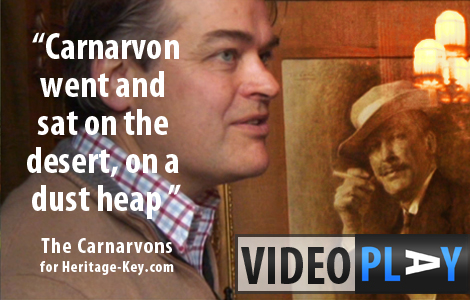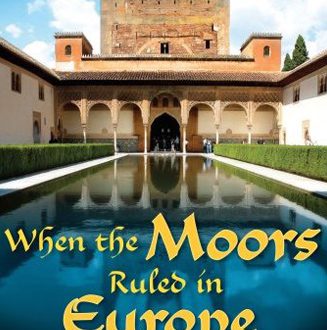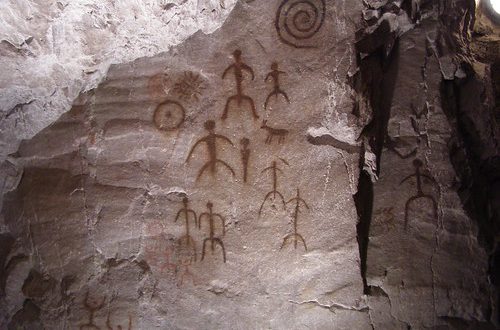 “There is a bit of an Indiana Jones style to that portrait of my great-grandfather, and it rather sums up his character.” George Herbert, 8th Earl of Carnarvon looks up at the image of his namesake forebear admiringly. A dashing 5th Earl of Carnarvon looks playfully down the barrel of a cigarette, rogueish grin etched upon his face. No wonder he’s smiling: George Edward Stanhope Molyneux Herbert, 5th Earl of Carnarvon is an archaeological legend – the man who alongside Howard Carter unlocked the 3,200-year-old secrets of Tutankhamun, Egypt’s boy-king.
“There is a bit of an Indiana Jones style to that portrait of my great-grandfather, and it rather sums up his character.” George Herbert, 8th Earl of Carnarvon looks up at the image of his namesake forebear admiringly. A dashing 5th Earl of Carnarvon looks playfully down the barrel of a cigarette, rogueish grin etched upon his face. No wonder he’s smiling: George Edward Stanhope Molyneux Herbert, 5th Earl of Carnarvon is an archaeological legend – the man who alongside Howard Carter unlocked the 3,200-year-old secrets of Tutankhamun, Egypt’s boy-king.
Adventure, it seemed, was in Carnarvon’s blood. Born into immense wealth, the young aristrocrat could have carved an easy life moving between mansions, estates and the family seat at Highclere Castle. “”He loved Highclere and he loved the very comfortable, Edwardian life here,” says his great-grandson. “But he also loved travel and adventure.”
But it wasn’t just the ancient world which fascinated Carnarvon. Well versed in aviation, he helped Geoffrey de Havilland get one of his first designs off the ground in 1909. But cars were his greatest love. A lifelong petrolhead, he pioneered racers at the turn of the 20th century, travelling the continent in search of speed. It would nearly prove his end when, in Germany, he swerved, hit a pile of rocks and smashed into the scenery. Carnarvon escaped, albeit with a seriously damaged leg: doctors urged him to eschew the cold wet winters of Britain for warmer climes.
 Egypt beckoned, but Carnarvon wasn’t happy with the high life of his peers: “A lot of people went out to Egypt as part of a social life in Cairo,” says the 8th Earl, “but that wasn’t his interest at all: he’d have been bored stiff if he was stuck just doing that.” The early 20th century was seeing some spectacular archaeological breakthoughs. The excitement of the technologies of the future were twinned with a fascination for the past.
Egypt beckoned, but Carnarvon wasn’t happy with the high life of his peers: “A lot of people went out to Egypt as part of a social life in Cairo,” says the 8th Earl, “but that wasn’t his interest at all: he’d have been bored stiff if he was stuck just doing that.” The early 20th century was seeing some spectacular archaeological breakthoughs. The excitement of the technologies of the future were twinned with a fascination for the past.
Enthralled with Egypt’s rich history, Carnarvon set out to discover its hidden secrets. By this time he was accompanied by his wife Almina Wombwell: ostensibly the daughter of an army captain but really the illegitimate child of banking tycoon Alfred de Rothschild.
De Rothschild doted on his daughter, giving her and her husband the money they needed to conduct more and more adventurous digs. An early mission saw months of work rewarded with just one mummified cat. Unpeturbed, Carnarvon continued in his quest, with Almina constantly by his side. “She was his friend, partner and wife,” says Fiona, 8th Countess of Carnarvon, “who started with these huge amounts of money. And clearly it developed into a great relationship.”
The couple would soon make the greatest discovery in history. But for that, and the tragic events surrounding Carnarvon’s death, you’ll have to check in to the next in our special series. Look out for our forthcoming ‘Ancient World in London’ series, when we’ll be exploring the great names of the Age of Discovery in Britain. You can even see us exploring the great archives of the Egypt Exploration Society in London, which feature the most famous archaeologists in history, here.
HDVideo: Discovering King Tut – 5th Earl of Carnarvon – Adventurous Life
(Click here to read the transcript)
Fiona Carnarvon has written two books on the King Tut tomb raid: Carnarvon & Carter(buy here) and Egypt at Highclere: The Discovery of Tutankhamun(buy here). You can watch every instalment of our special Discovering Tut video series right here at Heritage Key:
- Carter & Carnarvon: The Duo that Unlocked the Tomb of Tutankhamun (Watch the Video).
- Tutankhamun’s Tomb, the ‘House of Gold’ (Watch the Video).






